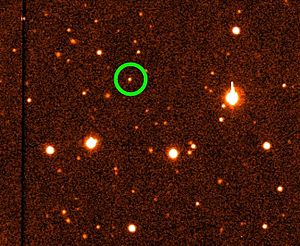90482 Orcus facts for kids
 |
|
| Discovery | |
|---|---|
| Discovered by | M. Brown, C. Trujillo, D. Rabinowitz |
| Discovery date | February 17, 2004 |
| Designations | |
| 2004 DW | |
| Plutino | |
| Orbital characteristics | |
| Epoch November 30, 2008 (JD 2 454 800) | |
| Aphelion | 7 188.17 Gm (48.05 AU) |
| Perihelion | 4 535.80 Gm (30.32 AU) |
| 5 862.44 Gm (39.188 AU) | |
| Eccentricity | 0.226 18 |
| 89 606 d (245.33 yr) | |
|
Average orbital speed
|
4.68 km/s |
| 164.68° | |
| Inclination | 20.593° |
| 268.722° | |
| 72.474° | |
| Known satellites | 1 (92-432 km) |
| Physical characteristics | |
| Dimensions | 946.3 +74.1−72.3 km (diameter) |
| Mass | ~7.5×1020 kg |
|
Mean density
|
~1.5 g/cm³ (assumed) |
| ~0.2 m/s² | |
| ~0.44 km/s | |
| 13.19h | |
| Albedo | 19.75 +3.40−2.76 % |
| Temperature | ~45 K |
|
Spectral type
|
B-V=0.68; V-R=0.37 |
| 19.1 (opposition) | |
| 2.3 | |
90482 Orcus is a dwarf planet that lives in the Kuiper belt. The Kuiper belt is a huge ring of icy objects beyond Neptune. Orcus was first called 2004 DW when it was found.
Three scientists named Michael Brown, Chad Trujillo, and David Rabinowitz discovered Orcus. They found it on February 17, 2004. Interestingly, it had been seen in older pictures from November 8, 1951, but wasn't recognized as a dwarf planet then.
Orcus is special because it moves around the Sun in a way similar to Pluto. It has an orbital resonance with Neptune. This means that for every two times Neptune goes around the Sun, Orcus goes around three times. But here's the cool part: Orcus always stays on the opposite side of the Sun from Pluto!
Orcus's Moon
Orcus has its own moon! This moon was discovered on February 22, 2007.
Scientists found the moon very close to Orcus. They used special tools to measure its brightness. Based on how bright it is, they think the moon is about 220 kilometers (about 137 miles) wide. They believe this moon might be a smaller object from the Kuiper belt that Orcus's gravity pulled in.
| The Solar System | |||||||
|---|---|---|---|---|---|---|---|
|
|
|||||||
| Sun • Heliosphere |
Planets ☾ = moon(s) ∅ = rings |
Mercury | Venus | Earth ☾ | Mars ☾ | ||
| Jupiter ☾ ∅ | Saturn ☾ ∅ | Uranus ☾ ∅ | Neptune ☾ ∅ | ||||
| Dwarf planets | Ceres | Pluto ☾ | Haumea ☾ | Makemake | |||
| Eris ☾ | |||||||
| Small Solar System bodies |
Asteroids (minor planets) |
Groups and families: Vulcanoids · Near-Earth asteroids · Asteroid belt Jupiter Trojans · Centaurs · Neptune Trojans · Asteroid moons · Meteoroids · Pallas · Juno · Vesta · Hygiea · Interamnia · Europa |
|||||
| See also the list of asteroids. | |||||||
| Trans- Neptunians |
Kuiper belt – Plutinos: Orcus · Ixion – Cubewanos: Varuna · Quaoar · Huya |
||||||
| Scattered disc: Sedna | |||||||
| Comets | Periodic comets and non-periodic comets Damocloids · Oort cloud |
||||||
| See also the list of solar system objects | |||||||
Images for kids
See also
 In Spanish: (90482) Orcus para niños
In Spanish: (90482) Orcus para niños





